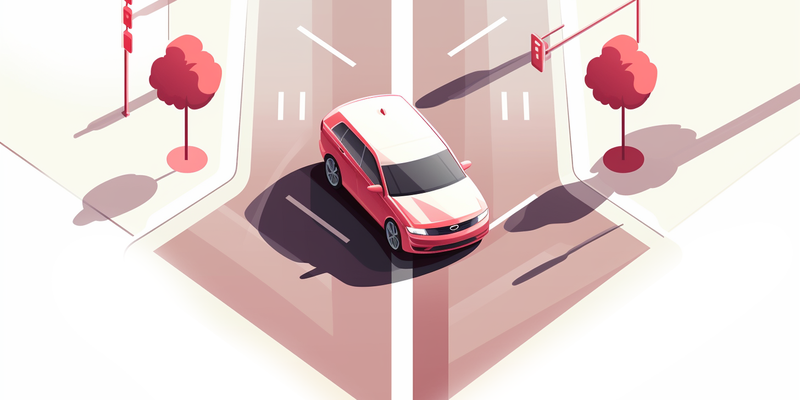
If you are not redirected within 30 seconds, please click here to continue.
Samedi: 10h – 16h HAE

If you are not redirected within 30 seconds, please click here to continue.
If you are not redirected within 30 seconds, please click here to continue.
Right-of-way in Canada: road rules explained

This article has been updated from a previous version.
Understanding right-of-way rules at intersections, whether you're making a turn, going straight, or navigating through, can sometimes prove challenging. You have to know when to yield (stop) and when to proceed cautiously – but drivers are often unsure of who should take the lead. Don’t worry, we’re here to help break the rules down!
What is right-of-way?
Right-of-way refers to the legal precedence given to one driver or vehicle over another in specific traffic situations. It dictates who has the authority to proceed first and who must yield in various driving scenarios.
Failing to adhere to these right-of-way rules can result in serious collisions. If you’re found guilty of failing to yield the right-of-way, or causing a collision by neglecting the rules for navigating oncoming traffic, you’ll likely be deemed at-fault for the accident.
Not only can they be dangerous for other drivers and pedestrians, these infractions can drive up your car insurance premiums by as much as 25 per cent. Moreover, traffic convictions can stay on your driving record for three years, and at-fault collisions can affect it for up to six years.
In Ontario, failing to yield the right-of-way can result in three demerit points and a fine of $110. In Alberta, a conviction for neglecting to yield the right-of-way may result in up to four demerit points and a fine of $575.
While the specific right-of-way rules are determined by the traffic laws in your province, these laws dictate when you must yield the right-of-way to another vehicle.
Read more: How a car accident affects your insurance premium
Common right-of-way scenarios
So now that you know how important how vital it is to yield the right-of-way. Here are a few common scenarios and how to navigate them safely:
Driving through a controlled or uncontrolled intersection.
Controlled intersections: These intersections feature traffic lights, stop signs, or yield signs clearly indicating which vehicle has the right-of-way. If the intersection also features a stop or yield sign, the first vehicle to arrive has the right to proceed first.
Uncontrolled intersections: In the absence of traffic lights, stop or yield signals, the first vehicle to reach the intersection gets the right-of-way.
In general, in both controlled and uncontrolled intersections, if multiple vehicles arrive simultaneously, the driver to your right always takes precedence. For roundabouts, always yield to oncoming traffic and pedestrians crossing from all directions before signaling when exiting. .
Making a left or right turn and merging into traffic.
Left turns: Making a left turn is one of the most accident-prone maneuvers. You must always yield to oncoming traffic, pedestrians and cyclists before making a left turn. An exception is when an intersection has traffic lights that display an advance green light (flashing green light or arrow) to allow for a driver turning left to have the right-of-way. If you’re turning left onto a multi-lane road, you must turn into the left lane first.
Right turns: For a right turn on a red light, yield to vehicles, pedestrians, and cyclists with a green light. At intersections with stop signs, wait for passing traffic, pedestrians, or cyclists before making your right turn. When turning onto multi-lane roads, stay in your lane and end up in the right lane.
When merging into traffic, whether it is a highway lane that is ending or an acceleration lane, any vehicle entering the flow of traffic must yield the right-of-way to the cars already in it.
Driving in a parking lot.
Navigating a parking lot can get confusing. Determining which driver has the right-of-way depends on whether you’re in a thoroughfare or feeder lane. Thoroughfares act as the main arteries of the parking lot, while feeder lanes are smaller lanes that typically connect and feed into a thoroughfare. Drivers in a thoroughfare usually have the right-of-way over those departing from feeder lanes.
Regardless of the lane type you’re in, you must yield the right-of-way to any approaching traffic, pedestrians, and cyclists when making left or right turns. Likewise, drivers exiting parking spaces should yield to those already travelling through the lane they intend to enter. This ensures the safety and smooth flow of traffic within the parking lot.
Read more: Car accidents in parking lots: who is at fault?
Entering traffic from a driveway and driving through crosswalks.
When exiting a driveway, whether it’s a residential one or a commercial parking lot, you must always yield the right-of-way to the drivers in the street and to pedestrians or cyclists on the sidewalk. Crosswalks and school crossings follow a strict protocol - you must wait for pedestrians to cross the street before proceeding.
When in doubt, yield
When approaching an intersection and you aren’t certain if you have the right-of-way, err on the side of caution. Make sure to yield to any vehicle already in motion, or when you’re moving from a stopped position into traffic.
Additionally, remember to always yield and pull over for any emergency vehicles with their lights flashing, as they demand immediate attention. You must pull over to let them pass safely. When you encounter a school bus with its red lights flashing, it’s crucial to come to a complete stop.
Common right-of-way mistakes
Failure to yield to pedestrians. Canadian driving laws mandate that drivers must always yield the right-of-way to pedestrians in crosswalks or at intersections, even if there are no marked crosswalks.
Ignoring four-way stops. At four-way stops, all vehicles must come to a complete stop. The right-of-way is determined by the order in which vehicles arrive at the intersection. Many drivers make the mistake of not coming to a full stop, or they assume they have the right-of-way without properly assessing the situation, leading to dangerous conflicts.
Misjudging merge lanes. When two lanes merge into one, drivers on the lane that is ending must yield to those in the continuing lane. Common mistakes include not signaling properly or attempting to merge aggressively.
Misinterpreting roundabouts. The rule is simple: yield to vehicles already inside the circle.
Retaliating with road rage. Road rage often stems from a misunderstanding or misinterpretation of right-of-way rules. If a driver feels they’ve unfairly denied their right-of-way, anger can quickly escalate. This can lead to aggressive driving behaviors such as tailgating, honking, or aggressive lane changes.
Right-of-way rules are there for a reason. Following these tips will help you reduce traffic conflicts and accidents, keep your car insurance rate affordable, and ensure the smooth and predictable movement of vehicles, pedestrians, and cyclists on our roadways.
Read next: A guide to getting your driver's licence in Ontario
Don't waste time calling around for auto insurance
Use RATESDOTCA to shop around, and compare multiple quotes at the same time.
Get money-saving tips in your inbox.
Stay on top of personal finance tips from our money experts!









